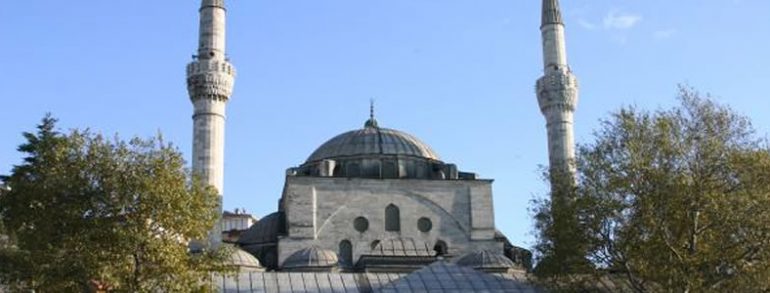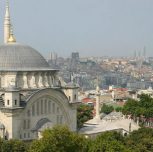It is one of the two complexes in Istanbul which were built on the instructions of Süleyman the Magnificient in 1548 in memory of his daughter Mihrimah Sultan, and has an attribute of carrying the same name in Edirnekapi District. The historical complex was located over against the port side of Uskudar in 1548. In addition, it was built by Sinan the Architect in the same period with the Şehzade Mosque (Prince Mosque). It contained a mosque, a school for children, a fountain, a medresse consisting of sixteen rooms, a guesthouse of eight rooms, a stable, a larder, a store house and a caravanserai. It now consists of five sections: mosque, madrasah (theological school attached to a mosque), the tomb of Sinaneddin Yusuf Paşa and the tomb of İbrahim Ethem Paşa.
Mosque
The diameter of the dome of the mosque is 10 m. There are two huge minarets having one balcony (sherefe) each. The decorative niche (mihrab) and the marble pulpit (mimber) reflect the formats of the Classical Ottoman Architecture. It is one of the few premier structures preserving the traces of the past on the Anatolian side of Istanbul. While the structure offers a distinct aesthetic view with a porch that covers the last prayer section, there is a twenty-cornered fountain located on the seaward side of the mosque.
Other Structures
The other sections of the mosque could not be reached until today. The Madrasah (religious school) is composed of 16 rooms that is being used as a health clinic today, the tomb of the two sons of Mihrimah Sultan, the tomb of the Osman Aga, son of Rustem Pasa-Grand (Grand Viziers of the Ottoman Empire), and the tomb of Sinan Pasa, Admirals of the Navy (Kaptan-ı Derya) are the structures that have stood until today. The other building in the complex is a Quranic primary school (Sıbyan Mektebi), which consisted of a domed porch and classroom. The tabhane (hostel) disappeared during the fire in 1772 and the inn and kitchen have also been completely cleared away.










